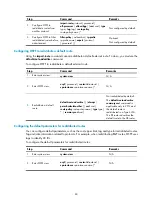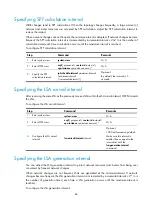
71
BFD
Bidirectional forwarding detection (BFD) provides a single mechanism to quickly detect and monitor the
connectivity of links between OSPF neighbors, reducing network convergence time. For more information
about BFD, see
High Availability Configuration Guide
.
Protocols and standards
•
RFC 1765,
OSPF Database Overflow
•
RFC 2328,
OSPF Version 2
•
RFC 3101,
OSPF Not-So-Stubby Area (NSSA) Option
•
RFC 3137,
OSPF Stub Router Advertisement
•
RFC 3630,
Traffic Engineering Extensions to OSPF Version 2
•
RFC 4811,
OSPF Out-of-Band LSDB Resynchronization
•
RFC 4812,
OSPF Restart Signaling
•
RFC 4813,
OSPF Link-Local Signaling
OSPF configuration task list
Make a proper plan before configuring OSPF.
To run OSPF in a routing domain, you must first enable OSPF on the routers. Then use the default settings
of parameters such as the hello interval, LSA delay timer, and SPF calculation interval. You can also
configure them as needed. OSPF routers should be configured on an area basis. Wrong configurations
may cause communication failures, routing information blocks, and routing loops.
Complete the following tasks to configure OSPF:
Task
Remarks
Required
Optional
Configuring OSPF
network types
Configuring the broadcast network type for an interface
Optional
Configuring the NBMA network type for an interface
Optional
Configuring the P2MP network type for an interface
Optional
Configuring the P2P network type for an interface
Optional
Configuring OSPF route
control
Configuring OSPF route summarization
Optional
Configuring OSPF inbound route filtering
Optional
Configuring ABR Type-3 LSA filtering
Optional
Configuring an OSPF cost for an interface
Optional
Configuring the maximum number of OSPF routes
Optional
Configuring the maximum number of ECMP routes
Optional
Optional
















































